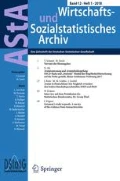Abstract
Survey practitioners regularly face the task to draw a sample from a (sub-) population for which no sampling frame exists. Indirect sampling might be a way out in such situations, given that connections exist between the target population and another population for which probability sampling is feasible. While the theory of indirect sampling originated in the context of household panel studies, a wider area of applications emerged during the last decade. We first give a short review of the theory of indirect sampling, show that estimators from indirect samples might have smaller variance than the corresponding direct estimators (contrary to some claims in the literature), summarize recent applications and discuss some issues that are relevant for applying indirect sampling in practice. We also present some theory for unbiased estimation after an additional subsampling stage that was necessary for sampling kindergarten children in the German National Educational Panel Study (NEPS).
Zusammenfassung
In der Umfragepraxis stellt sich oft das Problem, eine Stichprobe aus einer (Sub-)Population zu ziehen, für die kein vollständiger Auswahlrahmen existiert. In dieser Situation kann ein indirektes Auswahlverfahren eine Lösung sein, falls gewisse Verbindungen bestehen zwischen der Zielpopulation und einer anderen Gesamtheit, für die wiederum ein Auswahlrahmen existiert. Die nötige Theorie zur indirekten Auswahl wurde im Kontext von Haushaltsstichproben entwickelt; in den letzten Jahren ergaben sich aber zahlreiche weitere Anwendungsmöglichkeiten. Dieser Beitrag gibt einen Überblick über die Methodik der indirekten Auswahl, beschreibt einige Anwendungen aus jüngerer Zeit und diskutiert praktische Aspekte. Gezeigt wird zudem, dass Schätzer für indirekte Auswahlen durchaus kleinere Varianzen als direkte Schätzer haben können. Schließlich wird ein zusätzlicher Substichprobenschritt für eine Anwendung im Nationalen Bildungspanel (NEPS) beschrieben.



Similar content being viewed by others
Notes
Kalton and Brick (1995, p.37) look at the expected value of \(\hat{t}_{Y,\mathop{\mathrm{IS}}}\) given a sample \(s_{B}\) and write (in our notation): \(E(\hat{t}_{Y,\mathop{\mathrm{IS}}}|s_{B})=E(\sum_{i\in U_{B}}w_{i_{s}}y_{i}|s_{B})=\sum_{i\in s_{B}}E(w_{i_{s}}|i\in s_{B})y_{i}=\hat{t}_{Y,HT}\). The next-to-last equality is wrong. \(E(w_{i_{s}}|s_{B})\) is not equal to \(E(w_{i_{s}}|i\in s_{B})\): the first expectation is over all direct samples \(s_{A}\) which lead to the specified indirect sample \(s_{B}\), the second expectation is over all direct samples which lead to any indirect sample that contains unit \(i\). There is no reason why these expectations should be equal, and, in fact, they are usually different.
References
Ardilly P, Le Blanc D (2001) Sampling and Weighting a Survey of Homeless Persons: A French Example. Surv Methodol 27:109–118
Aßmann C, Steinhauer HW, Kiesl H, Koch S, Schönberger B, Müller-Kuller A, Rohwer G, Rässler S, Blossfeld H-P (2011) Sampling Design of the National Educational Panel Study: Challenges and Solutions. In: Blossfeld H-P, Roßbach H-G, Maurice J von (Hrsg) Education as a Lifelong Process. The German National Educational Panel Study (NEPS) (Zeitschrift für Erziehungswissenschaft, Special Issue 14), S 51–65
Deville J-C, Lavallée P (2006) Indirect Sampling: the Foundations of the Generalised Weight Share Method. Surv Methodol 32:165–176
Deville J-C, Maumy-Bertrand M (2006) Extension of the Indirect Sampling Method and Its Application to Tourism. Surv Methodol 32:177–185
Ernst L (1989) Weighting issues for longitudinal household and family estimates. In: Kasprzyk D, Duncan G, Kalton G, Singh MP (Hrsg) Panel Surveys. John Wiley and Sons, New York, S 139–159
Jauffret-Roustide M, Le Strat Y, Couturier E, Thierry D, Rondy M, Quaglia M, Razafandratsima N, Emmanuelli J, Guibert G, Barin F, Desenclos JC (2009) A national cross-sectional study among drug-users in France: epidemiology of HCV and highlight on practical and statistical aspects of the design. BMC Infect Dis 9:113–124
Kalton G, Brick JM (1995) Weighting schemes for household surveys. Surv Methodol 21:33–44
Kiesl H (2010) Selecting kindergarten children by three stage indirect sampling, in: Proceedings of the Joint Statistical Meetings 2010, Section on Survey Research Methods. American Statistical Association, Alexandria, VA, S 2730–2738
Lavallée P (1995) Cross-sectional Weighting of Longitudinal Surveys of Individuals and Households Using the Weight Share Method. Surv Methodol 21:25–32
Lavallée P (2007) Indirect Sampling. Springer, New York
Maia M (2009) Indirect Sampling in Context of Multiple Frames. In: Proceedings of the Joint Statistical Meetings 2009. Section on Survey Research Methods. American Statistical Association, Alexandria, VA, S 1769–1777
Rendtel U (1997) Überblick über unterschiedliche Konzepte bei der Gewichtung von Paneldaten. In: Hujer R, Rendtel U, Wagner G (Hrsg) Wirtschafts- und sozialwissenschaftliche Panel-Studien. Vandenhoeck & Ruprecht, Göttingen, S 35–52
Rendtel U, Harms T (2009) Weighting and Calibration for Household Panels. In: Lynn P (Hrsg) Methodology of Longitudinal Surveys. John Wiley and Sons, Chichester, S 265–286
Särndal C-E, Swensson B, Wretman J (1992) Model Assisted Survey Sampling. Springer, New York
Schonlau M, Kroh M, Watson N (2013) The Implementation of cross-sectional weights in household panel surveys. Stat Surv 7:37–57
Spiess M, Rendtel U (2000) Combining an ongoing panel with a new cross-sectional sample, Discussion Paper No. 198. German Institute for Economic Research (DIW)
Steinhauer HW, Aßmann C, Zinn S, Goßmann S, Rässler S (2015) Sampling and Weighting Cohort Samples in Institutional Contexts. Asta Wirtschafts- Sozialstatistisches Arch 9:131–157
Wolter KM, Smith P, Blumberg SJ (2010) Statistical foundations of cell-phone surveys. Surv Methodol 36:203–215
Xu X, Lavallée P (2009) Treatments for link nonresponse in indirect sampling. Surv Methodol 35:153–164
Author information
Authors and Affiliations
Corresponding author
Additional information
This work was partially funded by the German Research Foundation (DFG), Priority Programme “Education as a lifelong process” (SPP 1646) under the grant KI 1646/1-1.
Rights and permissions
About this article
Cite this article
Kiesl, H. Indirect Sampling: A Review of Theory and Recent Applications. AStA Wirtsch Sozialstat Arch 10, 289–303 (2016). https://doi.org/10.1007/s11943-016-0183-3
Received:
Accepted:
Published:
Issue Date:
DOI: https://doi.org/10.1007/s11943-016-0183-3




